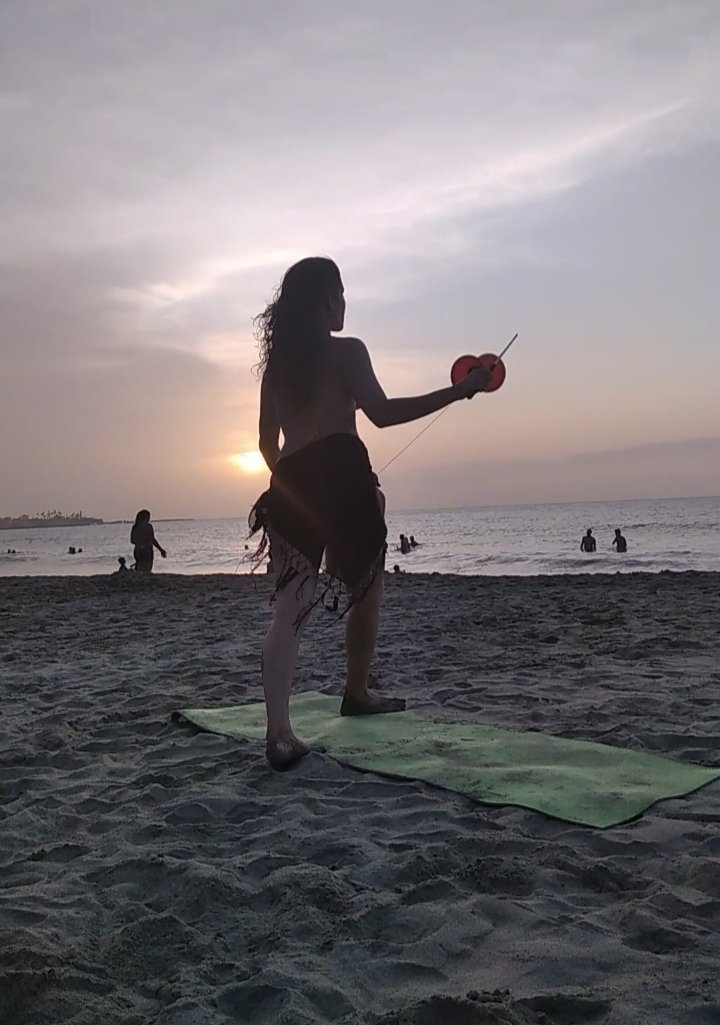
La Guaira, Venezuela.
Hola comunidad maravillosa. Hoy les hablaré un poco acerca del diabolo. El día que fui a la playa pude jugar un rato con el diabolo, mucha gente me veía extrañada al ver ese objeto desconocido que yo movía de un lado a otro y de arriba hacia abajo. Por eso quise hablar un poco y compartir sobre este arte.
Hello wonderful community. Today I will tell you a little about the devil. The day I went to the beach I was able to play for a while with the devil, many people saw me surprised when they saw that unknown object that I moved from one side to another and from top to bottom. So I wanted to talk a bit and share about this art.


Desde el 2013 vengo practicando con el diabolo, cada vez que juego aprendo y puso un poco más la técnica. No he sido constante con el, pero cuando lo tomó y juego con el, es como si el tiempo no hubiera pasado.
Since 2013 I have been practicing with the devil, every time I play I learn and put a little more technique. I have not been constant with it, but when I took it and played with it, it is as if time had not passed.



Acá les dejo un poco acerca de lo que es el diabolo, les dejo también el link de la página: https://es.toluna.com/opinions/2537244/El-Di%C3%A1bolo,-Origen,i-historia-y-Construcci%C3%B3n, por si quieren saber más.*
"Este juego malabar fue inventado en China durante la dinastía Han (206 a. C. 220), aunque se
afirma que ya existía en la dinastía Chang ( - 1112 a. C.), lo que supondría casi 4.000 años de historia.
Bautizado como Kouengen, que significa "hacer silbar el tronco hueco de bambú", el diábolo llegó a Europa de manos de los misioneros jesuitas a fines del siglo XVII.
Tanto fue su éxito en Inglaterra y Francia que, desde 1810, se crearon clubs y competiciones entre la alta sociedad.
En 1906, el francés Gustave Philippart diseñó un diábolo de metal y caucho. El "juguete" fue traído a Europa por los franceses y los expedicionarios.
En Inglaterra le dieron el nombre de "DIABALLO " (el cual se convirtió en Diábolo) que viene del Griego antiguo: tiro del "diámetro" y "ballo".Su práctica disminuyó después de la Primera Guerra Mundial, pero a partir de los años 80 comenzó una "etapa dorada" con la aparición de nuevos materiales y coloridos diseños que lo han vuelto a hacer popular. A partir de esa época, empezaron a surgir nuevos materiales que permitían trucos nuevos e incluso diábolos de fuego y agua.
- Descripción del material.
Un diábolo está formado por dos semiesferas huecas unidas por un eje metálico por donde se pasa una cuerda amarrada a dos palos.
Here I leave you a little about what the diabolo is, I also leave you the link of the page: https://es.toluna.com/opinions/2537244/El-Di%C3%A1bolo,-Origen,-historia-y-Construcci%C3%B3n, in case you want to know more.*
"This juggling game was invented in China during the Han dynasty (206 BC 220), although it was affirms that it already existed in the Chang dynasty (- 1112 BC), which would suppose almost 4,000 years of history.
Named Kouengen, which means "to make the hollow bamboo trunk whistle," the diabolo arrived in Europe from the hands of Jesuit missionaries at the end of the 17th century.
It was so successful in England and France that, from 1810, clubs and competitions were created among high society.
In 1906, the Frenchman Gustave Philippart designed a metal and rubber diabolo. The "toy" was brought to Europe by the French and the expeditionaries.
- In England they gave it the name "DEVIL" (which became Diabolo) which comes from ancient Greek: shot of the "diameter" and "ballo".*
Its practice declined after the First World War, but a "golden age" began in the 1980s with the appearance of new materials and colorful designs that have made it popular again. From that time on, new materials began to emerge that allowed new tricks and even fire and water diabolos.
- Material description.
A diabolo is made up of two hollow hemispheres joined by a metal shaft through which a rope tied to two poles passes.